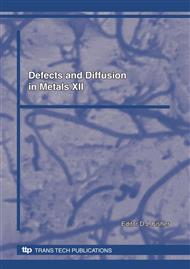p.1
p.15
p.23
p.33
p.39
p.49
p.55
p.61
p.71
Density Functional Theory Study of Kink with P in BCC Iron
Abstract:
The optimal geometries and mechanical properties of a kink with P are studied by applying density functional theory to the ½[111](1¯10) edge dislocation in bcc iron. The calculated impurity segregation energy shows that the P atom can be potentially trapped by the kink, and the doping P preferably segregates to the core region of the ½[111](1¯10) edge dislocation rather than to the <100>(010) edge dislocation. The analysis of the electronic structure indicates that the sideward motion of the kink is impeded owing to strong a interaction between P and neighboring Fe atoms. That is, the P induces a pinning effect on the ½[111](1¯10) edge dislocation. The hybridizations between P and Fe come from P 3p and Fe 3d4s4p. The p and d states have an obvious orientation, which may not be favorable to the toughness of iron. The localized effect of the P-kink complex distinctly affects the electronic structure as well as the energy of the system.
Info:
Periodical:
Pages:
39-47
Citation:
Online since:
October 2010
Authors:
Keywords:
Price:
Сopyright:
© 2010 Trans Tech Publications Ltd. All Rights Reserved
Share:
Citation:


